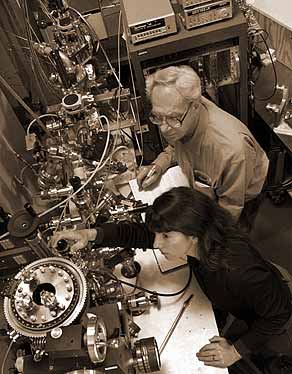|
Melvin P. Klein, a biophysicist noted for applying advanced
experimental techniques to biological problems, died suddenly at his home
in Berkeley on Sunday, May 28. He was 78.
 |

MEL KLEIN STUDIED PROTEINS USING AN ADVANCED LIGHT SOURCE
BEAMLINE WHICH HE HELPED DESIGN AND BUILD. HE IS PICTURED WITH KAREN
MCFARLANE.
|
Klein was a senior physicist, emeritus in the Physical Biosciences
Division and a member of the Chemistry Department at UC Berkeley. At the
time of his death he was actively pursuing research into the
oxygen-evolving system in plants -- the source of the world's oxygen
supply -- a field to which he had made fundamental contributions for the
past quarter century.
Born in Denver in 1921, as a boy Klein was an enthusiastic gadgeteer --
by age 11 he was a ham radio operator. He studied engineering at the
University of Denver, and during World War II he served as a civilian
radio engineer for the Army Air Corps, the Office of War Information, the
Harvard Radio Research Laboratory, and the intelligence section of Gen.
Douglass MacArthur's forces in the Pacific.
At UC Berkeley after the war he concentrated on physics and biophysics
after a year in medical school, and received his A.B. in 1952 and his
Ph.D. in biophysics in 1958. Meanwhile, he joined the Lab, then known as
the UC Radiation Laboratory.
While working on instrumentation for the Rad Lab's giant proton linear
accelerator near Livermore in the early 1950s, he became interested in the
phenomenon of nuclear magnetic resonance (NMR), which was yet to be
applied to medical imaging. With a colleague he developed a digital
computer-based signal averaging technique which, said Berkeley Lab
Director Charles Shank, became "the sine qua non of modern Fourier
transform NMR spectroscopy and has permeated most fields of experimental
science."
After spending a year at Bell Labs in New Jersey, Klein returned to the
Bay Area and in 1963 joined the laboratory run by Melvin Calvin on the
Berkeley campus -- today's Calvin Lab -- where he was named senior staff
scientist as part of Berkeley Lab's Chemical Biodynamics Division.
Except for brief sabbaticals (in Paris on a Guggenheim Fellowship in
1966-67 and in Berlin on a Humboldt Award in 1988-89), plus a very brief
retirement in 1991, Klein devoted the rest of his career to biophysics in
Berkeley.
Klein was a world-renowned leader in developing applications of NMR and
many other measurement techniques to biophysical problems. Notable was his
work on synchrotron-based x-ray spectroscopy. Klein was instrumental in
establishing biological research facilities at Berkeley Lab's Advanced
Light Source.
In announcing Klein's death, Graham Fleming, director of the Physical
Biosciences Division, wrote, "Mel embodied the spirit of curiosity
and interest in the world around him that marks a true scientist and an
intellectual ... To say he will be terribly missed is an insufficient
expression of our loss."
Klein's longtime collaborator on photosynthesis, Kenneth Sauer, said,
"He was a gentle soul and at the same time a great teacher and leader
who inspired students and postdocs and hundreds of good friends around the
world."
In October 1998, in a special issue of the Journal of Physical
Chemistry devoted to Klein and Sauer, their Berkeley Lab colleague
Alexander Pines wrote that "Mel Klein has educated generations of
students and postdocs, many of whom have gone on to stellar careers, and
he has been and remains an enduring inspiration to us all. But Mel also
has that rarest of human qualities, he is a mensch, a real mensch. Dear
Mel ... you have earned our love and our respect."
Klein is survived by his wife of 40 years, Margaret, their daughter
Adrienne, sons Mark and Peter, and two grandchildren.
A memorial service was held at the UC Berkeley Faculty Club on Friday,
June 9. |


